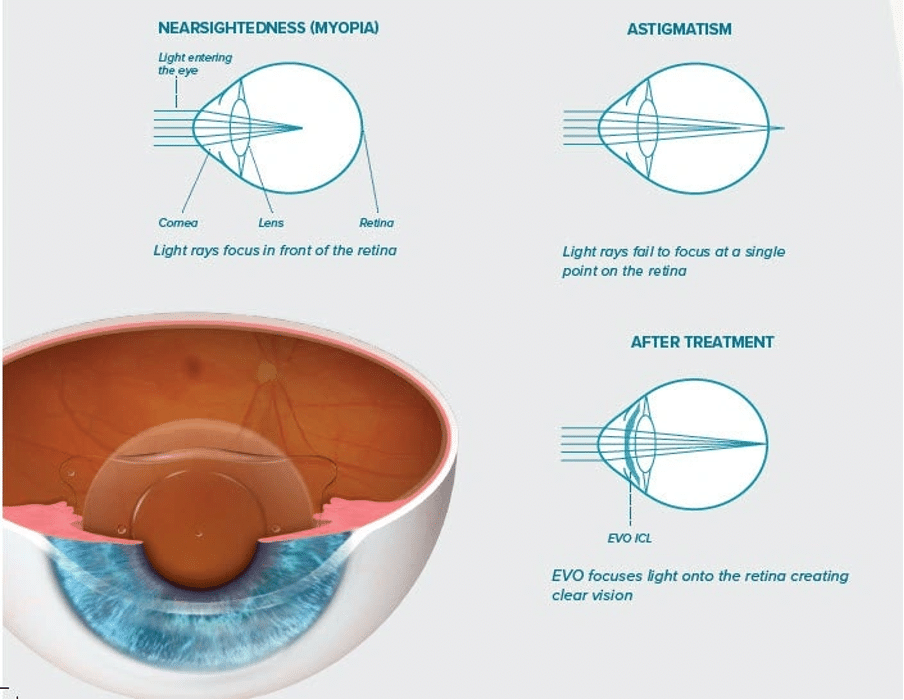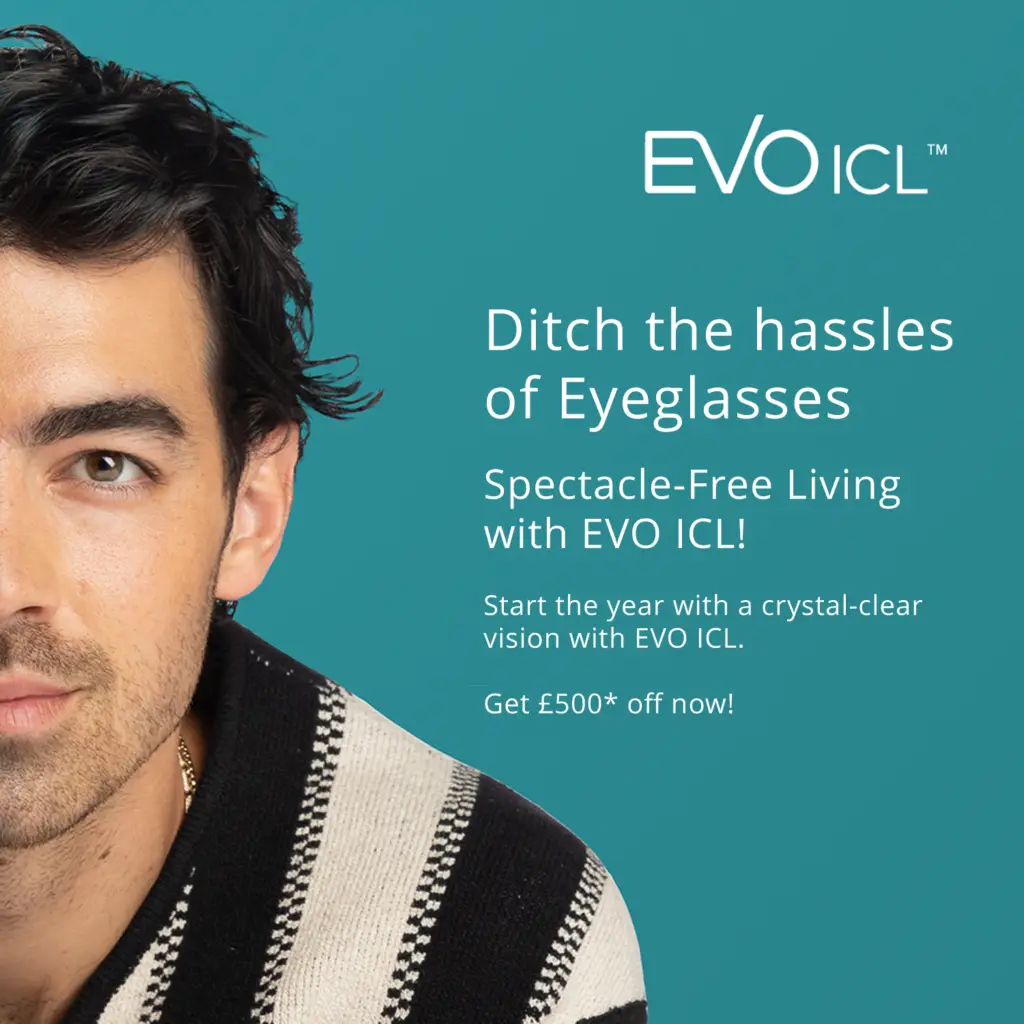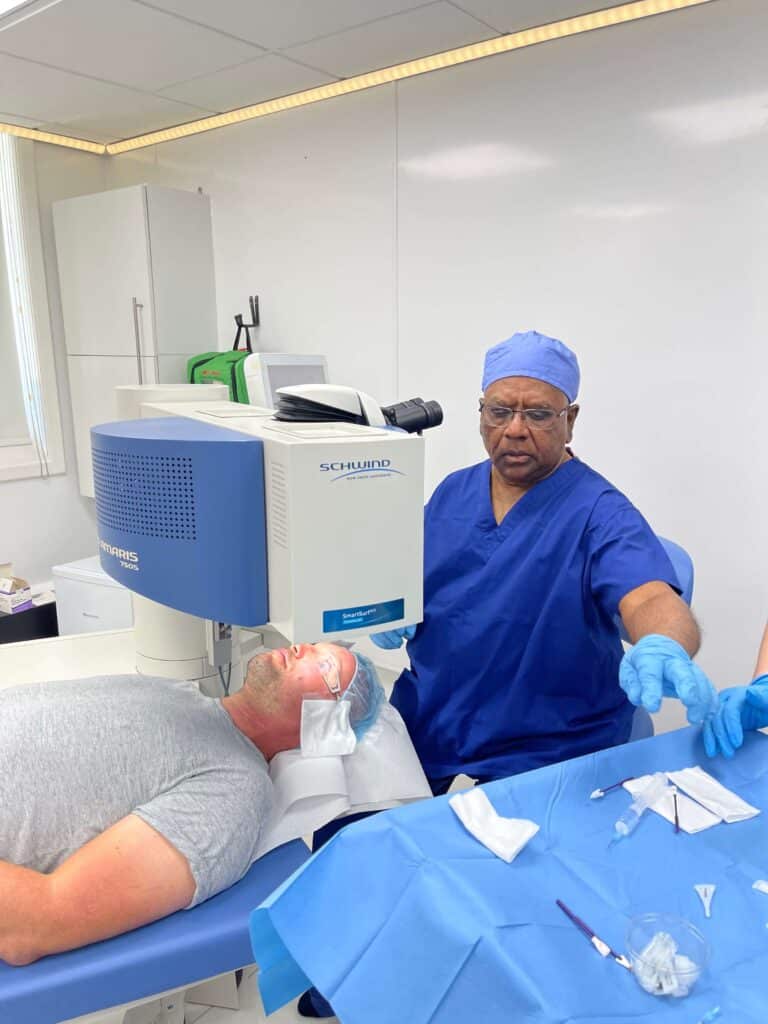LASIK after ICL surgery has become popular among patients who want perfect vision correction. The results speak for themselves – 94.5% of patients get 20/20 vision or better with ICL surgery alone. More than 3 million people worldwide have chosen Implantable Contact Lens (ICL) because it improves vision right away.
Let me explain what ICL is. Your surgeon places an implantable contact lens between your iris and natural lens. This works great for people with high prescriptions that LASIK alone might not fix completely. Some patients might still have slight astigmatism or minor vision issues after getting ICL. That’s when combining both procedures makes sense. Our team at Precision Vision London uses cutting-edge technology and expert surgical techniques to give you the best possible vision. The treatments are carefully timed and customised just for you. The satisfaction rate is amazing – 99.4% of ICL patients worldwide say they would do it again.
This piece will help you understand how these procedures work together. You’ll learn what makes someone a good candidate and why our UK specialists might suggest this approach based on your vision needs.

ICL Surgery as a Foundation for Vision Correction
Implantable Collamer Lenses create a solid foundation for vision correction, especially when patients face visual challenges that traditional procedures don’t deal very well with. These soft, flexible implants rest between your iris and natural lens and work like built-in contact lenses.
Why ICL is chosen for high or complex prescriptions
ICL stands out as a better option for patients with challenging vision needs. These lenses can successfully treat a wide range of prescriptions—up to -18.00D for short-sightedness, +10.00D for long-sightedness, and ±4.50D for astigmatism.
You might need ICL surgery if:
- Your corneas are too thin for LASIK
- You have existing corneal or eye surface problems
- You need correction for very high prescriptions
The ICL procedure keeps your corneal tissue intact since it doesn’t reshape the cornea. This preservation substantially reduces dry eye syndrome risk—a common post-LASIK issue—while your eye’s natural focusing power stays unchanged.
Long-term stability and reversibility of ICL lenses
Clinical studies show remarkable stability with ICL implantation. Research on patients over 40 years old revealed excellent safety and efficacy indices of 1.22 ± 0.26 and 0.88 ± 0.34 respectively. Studies that followed patients for more than 10 years also confirm consistent, reliable results. ICL surgery’s biggest advantage lies in its reversibility. Unlike corneal procedures that permanently change your eye structure, doctors can remove or replace ICLs if your vision needs change. This flexibility reassures patients since they’re not locked into a permanent change if:
- Their prescription changes over time
- They develop other eye conditions later in life
- New vision correction technologies emerge
How ICL supports future enhancements like LASIK
Precision Vision London recognises that ICL builds an ideal foundation for possible vision enhancements. Your corneal tissue stays completely intact, so you can still get LASIK adjustments if needed. Combining ICL with later LASIK—called a “bioptics” approach—can fix any remaining refractive errors after your primary ICL procedure. This approach lets doctors correct major vision issues with ICL first, then fine-tune vision with targeted laser treatments after your eyes stabilise completely. This combined method works particularly well for patients with superhigh myopia (beyond -12D) or complex astigmatism. It delivers optimal visual results through carefully planned, complementary procedures.

The Bioptics Approach: Combining ICL and LASIK
Bioptics provides a sophisticated solution to patients with complex vision needs pioneered in 1989. This technique combines ICL surgery with laser vision correction and achieves exceptional results that neither procedure could accomplish alone.
What is bioptics and how does it work?
Bioptics combines vision-correction refractive surgical techniques that treat refractive error on both lenticular and corneal optical planes. Our team at Precision Vision London uses this approach by first addressing most of your refractive error with an Implantable Collamer Lens. A laser procedure then fine-tunes any remaining imperfections. This two-step strategy delivers precision that a single procedure cannot achieve.
Ideal candidates for LASIK after ICL
The best candidates for bioptics include:
- Patients who need more than 15D of correction
- People with more than 10D of myopia and 2D of astigmatism
- Patients whose refraction has stabilised after ICL implantation
In some cases, LASIK after ICL can fine-tune your vision for even sharper results. Research shows that bioptics procedures achieve vision within 0.50D of target more often (94% versus 81%) compared to toric ICL implantation alone.
Timing and healing between procedures
The right timing between surgeries plays a significant role in optimal outcomes. Your eyes need to fully stabilise after ICL implantation before proceeding with LASIK enhancement. This requires:
- A minimum of three months post-ICL surgery
- Stable refraction, wavescan, and topography confirmation
- Complete healing of all incisions
Patients typically wait around 172 days between ICL implantation and excimer laser enhancement. This period can range from 87 to 557 days based on individual healing.
Surface laser adjustments for residual errors
Our surgeons use advanced wavefront-guided excimer laser technology to address slight astigmatism or residual refractive error after your ICL settles. This precise adjustment corrects:
- Minor residual myopia
- Astigmatism remaining after ICL placement
- Small hyperopic shifts
Our team uses advanced imaging throughout both procedures to ensure safety and predictability for your unique eyes.
Safety, Precision, and Patient Outcomes
The results of combined vision correction procedures tell a compelling story. Our patient data shows outstanding satisfaction rates that exceed 99.4% after ICL surgery alone. This builds trust in our approach.

UK-based success rates and satisfaction data
Our UK patients achieve exceptional visual results. Studies show 83% of eyes reaching 20/25 vision or better after bioptics procedures. The data gets better – 94% of eyes come within one line of their best corrected vision. Our long-term follow-ups show that 94.2% of patients experience better quality of life after their vision correction.
How we ensure safety with advanced imaging
Precision Vision London’s surgeons assess your eyes carefully to determine if a combined approach suits you. We use advanced very high-frequency ultrasound (VHFUS) technology that delivers exceptional resolution and repeatability. This technology measures precisely up to 0.12mm laterally behind the iris, so it reduces the risk of size-related complications.
Managing risks like dry eye or pressure changes
Patient safety remains our priority despite minimal risks. ICL procedures keep corneal nerve integrity intact and cause nowhere near as much dry eye as LASIK. The latest lens designs with central flow ports have reduced intraocular pressure complications to just 0.04%. Our overall complication rates stay below 0.1%.
Why LASIK after ICL is rarely needed—but effective
Modern ICL procedures achieve such precision that patients rarely need subsequent LASIK. Studies show 94% of eyes reach within 0.75D of intended correction. Fine-tuning through bioptics approaches delivers superior outcomes in cases where it helps. The safety index stays excellent at 1.00±0.13, and we’ve seen zero adverse events during follow-up periods.
Why Choose Precision Vision London for Combined Procedures
Expert surgeons who understand both procedures will help you choose the right vision correction path. Precision Vision London is an independent, surgeon-led practise in the heart of London’s prestigious Harley Street.

Our technology and diagnostic capabilities
Precision Vision uses only the most advanced technology. Our equipment has the SCHWIND AMARIS 1050RS—the world’s fastest excimer laser system that operates at 1050 Hz with extraordinary 7D eye tracking. This advanced system will give a precise outcome when performing LASIK after ICL surgery, especially for patients with slight astigmatism who need refinement.
Our complete diagnostic suite has:
- Sirius Corneal Topographer for detailed surface mapping
- Wavefront Analyser for detecting subtle visual aberrations
- Optical Coherence Tomography for assessing corneal thickness
Customised care from consultation to recovery
Your experience starts with a detailed consultation to assess if ICL or combined procedures suit you. We create a unique treatment plan based on your specific visual needs. Book your consultation today to find whether LASIK after ICL could give you the ultimate vision perfection.
Our care goes way beyond the reach and influence of the procedure—your comfort stays our priority with our treatment package that includes one full year of ongoing eye care. This ensures the best possible vision outcomes.
Trusted reputation and patient-first philosophy
Our world-renowned surgeon stays with each patient throughout their experience—from consultation through treatment and aftercare. This steadfast dedication to excellence has earned us recognition, including the 2024 Outstanding Patient Experience Award. With 94% of our patients achieving 20/20 vision or better, your vision rests in expert hands.
Conclusion
The combination of ICL and LASIK provides an exceptional approach to vision correction for patients with complex visual needs. This bioptics technique delivers remarkable precision, especially when you have prescriptions that traditional procedures don’t deal very well with. Modern ICL procedures achieve such outstanding results that patients rarely need LASIK enhancement. Yet this combined approach remains valuable for those who seek absolute visual perfection.
Your path to optimal vision starts with the right foundation. ICL surgery creates this foundation and preserves your corneal tissue completely. This means you stay eligible for future enhancements if needed. The reversible nature of ICL gives you peace of mind. You can make adjustments as your vision needs change over time.
The timing of procedures plays a significant role in successful outcomes. Our specialists at Precision Vision London make sure your eyes stabilise fully after ICL implantation before any laser enhancement. This patient-focused approach combined with our advanced diagnostics and technology like the SCHWIND AMARIS 1050RS delivers exceptional results. 94% of patients achieve 20/20 vision or better.
A remarkable 99.4% satisfaction rate among ICL patients proves how well this approach works. UK data backs these outcomes further. About 83% of eyes reach 20/25 vision or better after bioptics procedures. These numbers show our steadfast dedication to excellence throughout your treatment.
Your vision deserves the finest care available. Precision Vision London delivers this care through our surgeon-led practise, personalised treatment plans, and detailed aftercare. Our team stands ready to help you achieve the clearest, most stable vision possible for years to come – whether through ICL surgery alone or the combined bioptics approach.
Key Takeaways
Understanding the potential for combining ICL and LASIK procedures can help you make informed decisions about achieving optimal vision correction, particularly for complex prescriptions.
- ICL surgery preserves corneal tissue completely, making future LASIK enhancements possible whilst maintaining reversibility for changing vision needs.
- The bioptics approach combines ICL with LASIK to achieve 94% accuracy within 0.50D of target vision, superior to single procedures alone.
- LASIK after ICL is rarely needed due to modern precision, but when required, timing is crucial—wait minimum three months for stabilisation.
- Combined procedures achieve exceptional outcomes with 83% reaching 20/25 vision and 99.4% patient satisfaction rates in UK studies.
- Advanced diagnostic technology and surgeon-led care ensure safety, with complication rates below 0.1% and minimal dry eye risk compared to LASIK alone.
This combined approach represents the pinnacle of vision correction technology, offering patients with high prescriptions or complex visual needs a pathway to exceptional clarity that neither procedure could achieve independently.
FAQs
Q1. Is it possible to have LASIK after ICL surgery? Yes, it is possible to have LASIK after ICL surgery. This combined approach, known as bioptics, can be used to fine-tune vision and address any residual refractive errors after ICL implantation. However, it’s important to note that with modern ICL procedures, subsequent LASIK is rarely needed due to the high precision achieved.
Q2. How long should I wait between ICL and LASIK procedures? Typically, you should wait at least three months after ICL surgery before considering LASIK enhancement. This allows time for your eyes to fully stabilise and heal. The average time between ICL implantation and excimer laser enhancement is about 172 days, but it can range from 87 to 557 days depending on individual healing.
Q3. What are the success rates for combined ICL and LASIK procedures? The success rates for combined ICL and LASIK procedures are impressive. Studies show that 83% of eyes achieve 20/25 vision or better following bioptics procedures. Additionally, 94% of eyes come within one line of their best corrected vision, and 94.2% of patients report improved quality of life after vision correction.
Q4. Are there any risks associated with having both ICL and LASIK? While there are minimal risks, patient safety is a top priority. ICL procedures maintain corneal nerve integrity, resulting in significantly less dry eye than LASIK alone. Recent lens designs have reduced intraocular pressure complications to just 0.04%. Overall complication rates remain below 0.1%. Advanced imaging techniques and careful patient assessment help ensure safety throughout the process.
Q5. Who is an ideal candidate for combined ICL and LASIK procedures? Ideal candidates for combined ICL and LASIK procedures typically include patients requiring more than 15D of correction, those with more than 10D of myopia and 2D of astigmatism, and individuals whose refraction has stabilised after ICL implantation. This approach is particularly beneficial for patients with superhigh myopia or complex astigmatism that cannot be fully corrected with a single procedure.
Authors & Reviewer
-
 Olivia: Author
Olivia: AuthorHi, I'm Olivia, a passionate writer specialising in eye care, vision health, and the latest advancements in optometry. I strive to craft informative and engaging articles that help readers make informed decisions about their eye health. With a keen eye for detail and a commitment to delivering accurate, research-backed content, I aim to educate and inspire through every piece I write.
-
 Dr. CT Pillai: Reviewer
Dr. CT Pillai: ReviewerDr. CT Pillai is a globally recognised ophthalmologist with over 30 years of experience, specialising in refractive surgery and general ophthalmology. Renowned for performing over 50,000 successful laser procedures.

